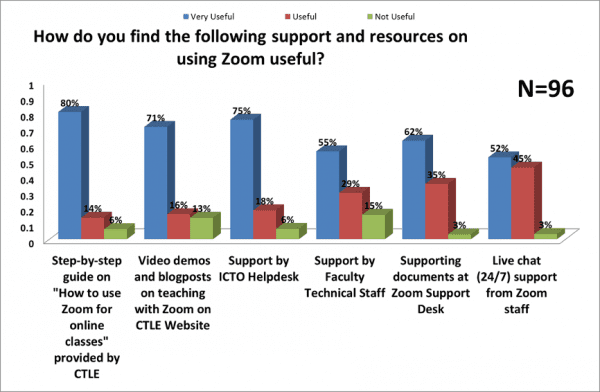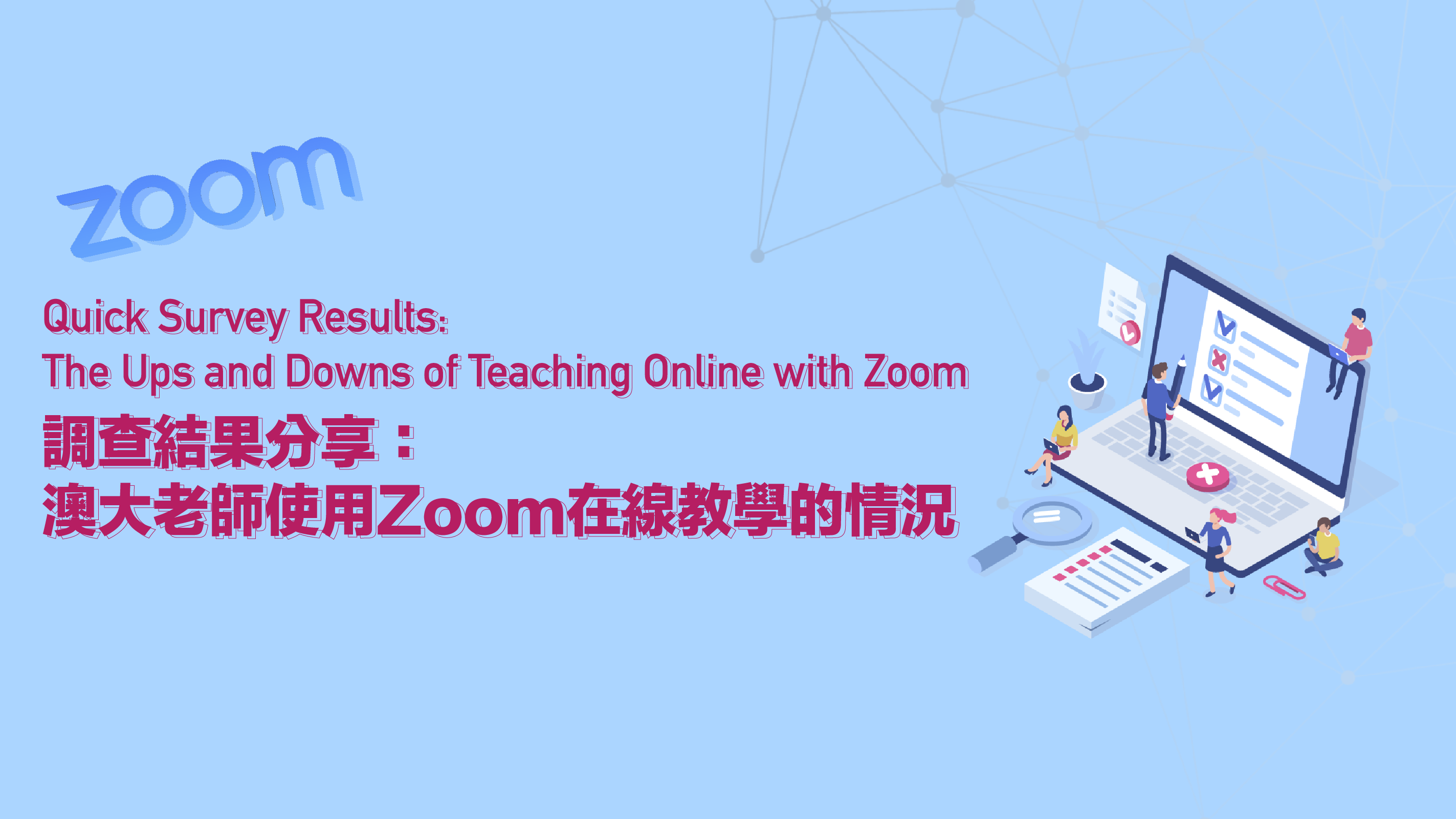Project Description
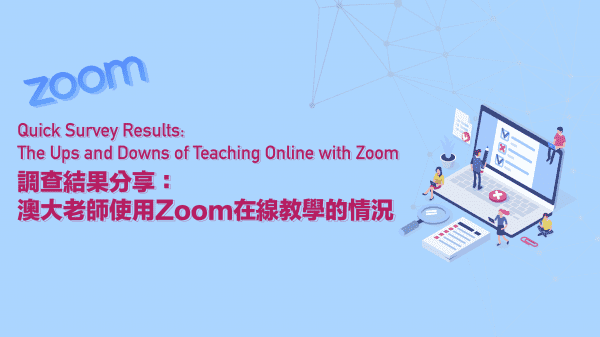
During the COVID-19 pandemic, faculty members at UM who are teaching online were asked about the ways in which they use the video conferencing software, Zoom. Survey responses indicated that the video conferencing system was used extensively by respondents for teaching online. However, faculty members found that teaching using Zoom presented technical and pedagogical challenges.
The results presented in this blog post are from a survey conducted by CTLE in March 2020. The survey aims to better understand the experiences and ways in which faculty members at the University of Macau are using Zoom during the COVID-19 pandemic. Responses from 138 faculty members were received.
The Ups
99% of respondents found that the Zoom video conferencing software facilitated online class meetings. Online class meetings consisted of lecturing and feedback activities in meetings which lasted less than 40-minutes, for 42% of respondents, whereas 25% of respondents indicated that class meetings lasted for more than 40-minutes.
Open-ended survey questions indicated that faculty members made use of most all of the features available, including screen sharing, chat, polls, etc. A prevailing response indicated that chat activities facilitated student participation and discussion. In addition, respondents noted that Zoom’s integration with UMMoodle facilitated communication and teaching.
The top three resources as indicated by respondents were a step-by-step guide on “How to use Zoom for online classes“, video demos and blogposts on CTLE’s website, and support from the ICTO Helpdesk.
The Downs
It has been an ongoing challenge for teachers to refine their online teaching materials and activities to align with students’ preferences.
Respondents were also concerned about unstable Internet connections, issues of access to IT systems from the Mainland, poor quality microphones, headphones and web-cameras, and a lack of software to edit video recordings. It has been indicated that “pro” licenses should be made available to all academic staff currently teaching.
Further Remarks and Data
Other challenges of using Zoom for teaching purposes were reported as follows:
· Time lag during screen sharing (teachers have to adjust the pace of teaching)
· Disengaged students and the difficulty to track student participation and understanding
· Lack of interactivity and eye-contact compared to face-to-face teaching in a classroom
· Lack of the necessary hardware, such as built-in camera, microphone, writing pad (for white board and annotation functions), headphone, to facilitate a quality Zoom session, and lack of software to edit video record of the lecture
· Need to multi-task (simultaneously teach, share/switch screens and read chat discussions)
· Lack of expertise in shooting conditions & techniques such as lighting, presenting a pleasant look in front of camera
· Not applicable to practical/skill-based course teaching which requires step-by-step demonstration
Data
Figure 1: For what do you use Zoom?

Figure 2. How do you use Zoom in UM courses?

Figure 3. Where do you find support?

在新冠肺炎大流行期間,澳大推行「停課不停學」,並利用線上會議程式Zoom進行在線教學,教與學優化中心對使用了該方式教學的澳大老師進行了問卷調查。調查結果顯示,在線會議被廣泛用於在線教學上,但同時他們也面臨技術和教學方面的挑戰。
本中心於上月底向澳大教職員發出了問卷,希望更好了解停課期間澳大教職員使用Zoom的經驗和方式,最後收到來自不同學院共138名教員的回覆。
好的方面
在線課堂會議主要由演講和反饋活動組成,幾乎全部的受訪者認為Zoom有效地促進了在線課堂會議,近四成老師的在線課堂持續不到40分鐘,而25%受訪者的課堂會議持續了40分鐘以上。
教職員在開放式問題裡表示,他們使用了可用的大多數功能,包括屏幕共享、聊天、投票等;聊天活動促進了學生的參與和討論,而Zoom與UMMoodle的交互使用促進了交流和教學。
排名前三的資源是“如何使用Zoom進行線上教學?”(連結)的分步指南,本中心網站影片及教學博客(連結),以及ICTO服務台的支持。
值得改善的地方
對老師來說,斷完善在線教學材料和活動,以適應學生的喜好,一直以來都是不間斷的挑戰。
受訪者擔心以下各種問題:網絡連接不穩定、內地使用Zoom情況、視訊連接工具如咪高峰、耳機和攝像頭質量較差,以及缺乏編輯影片的軟件等,更有受訪者表示,應向目前正在教學的所有學術人員提供Zoom的Pro License。
進一步的評論和數據
- 屏幕共享過程中的時間滯後(老師必須調整教學進度)
- 在線教學脫離學生,難以追踪學生的參與和理解
- 與課堂上的面對面教學相比,缺乏互動性和接觸
- 缺少必要的硬件,例如:內置攝像頭、咪高峰、手寫板(用於白板和註釋功能),耳機(無法實現高質素的Zoom對話),並且缺少用於編輯紀錄影片的軟件
- 需要執行多項任務(同時授課、共享/切換屏幕,以及閱讀聊天討論)
- 在拍攝條件和技術(例如照明)方面缺乏專業知識,無法在鏡頭前呈現清晰外觀
- 不適用於基於實踐/技能的課程,一般需要一步步示範
數據圖表
圖1:您將Zoom用作什麼?
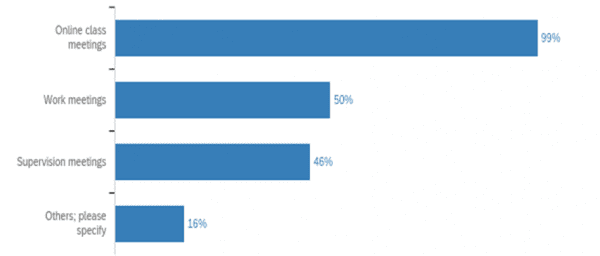
圖2.如何在澳大課程裡使用Zoom?
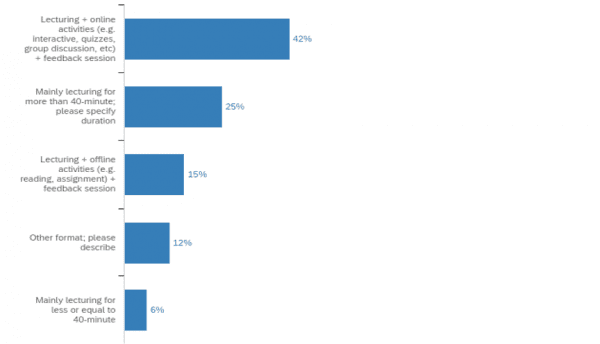
圖3.您在在哪裡找到技術支援?
